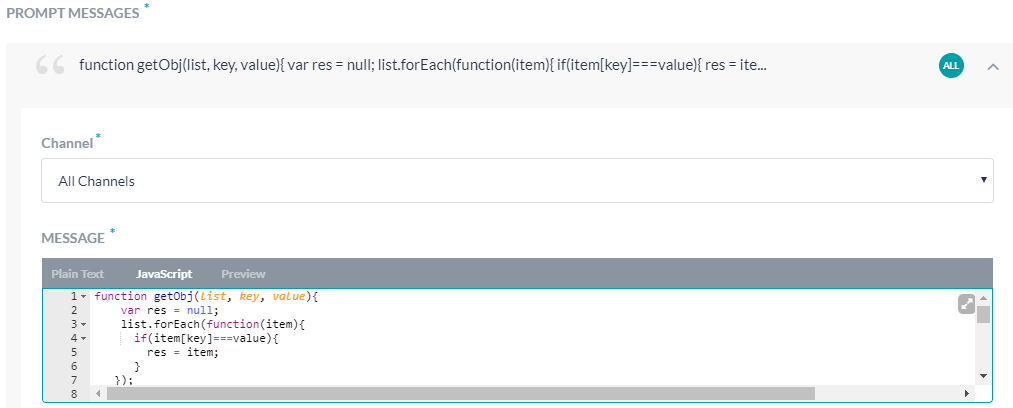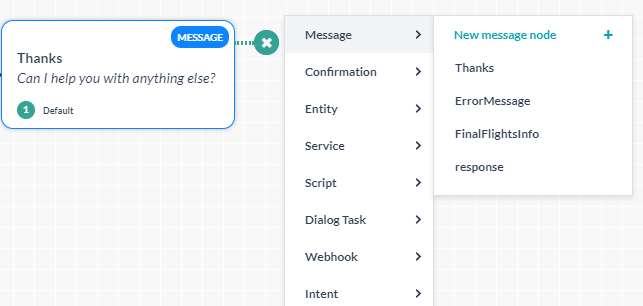The Message node can be used to deliver a message to the user. Message nodes commonly follow an API, web service call, or webhook event to define their results as a formatted response.
Bot responses can be formatted as follows:
- Plain text: Type a message in plain text. You can use stored context values with
{{variable brackets}}. Example:'Hello {{context.session.UserContext.firstName}}. How can I help you?' - Javascript: Compose JavaScript responses either:
- for dynamically constructing messages using context and session variables or
- for displaying templates or widgets as supported by various channels.
For example, you can compose a JavaScript message for Facebook Channel to present a Carousel template. - Optionally, you can generate links to view the information in an HTML report format using templates and share the URL with the bot message.
For example, the Book Flights sample dialog uses the following message nodes:
- WeatherReport: Shows the weather details returned by the WeatherApi Service node, formatted using the LocationScript node.
- FinalFlightinfo: Shows the flight itineraries that the Flights info service node returns.
- Thanks: After showing the final flight details, prompts the user if they have any other request.
Setting up a Message Node
Setting up a Message node in a Dialog task involves the following steps.
Step 1: Adding a Message Node to the Dialog Task
Step 2a: Configuring the Bot Response
- After you enter a Name and Display Name for the Message node
- You can use the Bot Responses section to compose and format the Bot response either as plain text or as a JavaScript message. A default message is set by the platform, you can customize it in the following ways:
- Edit the message directly and press enter. The message will be saved in the plain text format.
- Click Manage Responses. The Bot Responses window opens. You have further options:
- To edit the default sample message by adding context object variables or javascript code, click the sample message and make changes
- To add a new bot response, click Add Bot Response.
In the Channel drop-down list, All Channels is the default setting. To create a channel-specific message, select the channel from the list.
In the Message Editor, the Plain Text tab is the default selection. If you want to compose Javascript message, click the JavaScript tab.
Note: You can use any value that is currently stored in the context. Example:print('Hello'+ context.session.UserContext.firstName+ '. How can I help you')

- Compose the message and click Save.
To add any more bot responses, repeat from step 2b.
Step 2b: Generating Message as Report Link (Optional)
The Message node allows you to generate links to view the information in an HTML report format using templates. The URL link can be added to the Bot message. When you add a link to a bot response, the users can select the link and get more details, such as a table of values for Closed Sales Opportunities in the SalesForce Bot.
To generate a report link, follow these steps:
- At the bottom of the Component Properties panel, click the Generate Report Link.

- In the Generate Report Dialog, enter the following values:
- Link Title – The link text displayed in the bot channel, for example, View Shopping Cart.
- Header – The title of the report, for example, These are the items in your Shopping Cart.
- Details – End-user help information displayed directly below the Header, describing the content of the report. For example, Review your Shopping Cart, and then click Continue when you are ready to place your order.
- Data Path – Path for the data, usually the response from the web service. For example, context.ShoppingCartService.response.body
- Template – Select one of the following format templates to display the data from the task response. For each type, define the Column Name, Key Mapping, Data Type, and template-specific options.
- Table – Uses a table format with defined columns. Each mapping for the Table template can be set to Is Sortable, Display as an image, and Display it as a link. For more information, see Defining a Table Report.
- Fixed Column Table – Uses a table format with the one or more columns fixed. Each mapping for the Fixed Column Table template can be set to Is Sortable, Column in fixed, Display as an image, and Display it as a link. For more information, see Defining a Fixed-Column Table Report.
- Card Layout – Uses a contact card format. Each mapping for the Card Layout template can be set to Is Sortable, Display as an image, and Display it as a link. For more information, see Defining a Card Layout Report.
- Weather Info – Define a Date for a weather service response payload. Each mapping for the Weather Info template can be set to Is Sortable, Display as an image, and Display it as a link. For more information, see Defining a Weather Info Report.
- Card Layout with Group By – Shows a list of items grouped by a specific field. For more information, see Define a Card Layout with Group By Report.
Step 3: Configuring the Instance Properties
- Hold & Resume: Instance Property for a Message Node can be used to configure the Hold & Resume behavior for this node.
Note: The settings in the Instance Properties panel are specific to the current Task and do not reflect in the other dialog tasks that use this entity node.- Use the task level ‘Hold & Resume’ setting: The bot refers to the Hold & Resume settings set at the dialog task level.
- Customize for this node option: You can customize the Hold & Resume settings for this node by selecting this option and configuring the same. Read the Interruption Handling and Context Switching article for more information.
- Custom Tags defines tags to build custom profiles of your bot conversations. See here for more.
Step 4: Configuring the Connections Properties
From the node’s Connections panel you can determine which node in the dialog task to execute next. You can write the conditional statements based on the values of any Entity or Context Objects in the dialog task, or you can use intents for transitions.
To setup Component Transitions, follow these steps:
- You can select from the available nodes under the Default connections.
- To configure a conditional flow, click Add IF.
- Configure the conditional expression based on one of the following criteria:
- Entity: Compare an Entity node in the dialog with a specific value using one of these operators: Exists, equals to, greater than equals to, less than equals to, not equal to, greater than, and less than. Select the entity, operator using the respective drop-down lists, and type the number in the Value box. Example: PassengerCount (entity) greater than (operator) 5 (specified value)
- Context: Compare a context object in the dialog with a specific value using one of these operators: Exists, equals to, greater than equals to, less than equals to, not equal to, greater than, and less than. Example: Context.entity.PassengerCount (Context object) greater than (operator) 5 (specified value)
- Intent: Select an intent that should match the next user utterance.
- In the Then go to the drop-down list, select the next node to execute in the dialog flow if the conditional expression succeeds. For example, if the PassengerCount (entity) greater than (operator) 5 (specified value), Then go to Offers (sub-dialog).
- In the Else drop-down list, select the node to execute if the condition fails.
Step 5: Configuring the IVR Properties
You can use this tab for defining at the Node level the input mode, grammar, prompts and call behavior parameters for this node to be used in IVR Channel. Refer here for details

